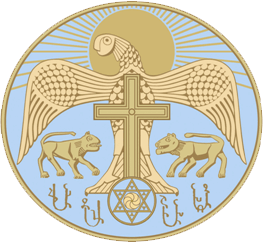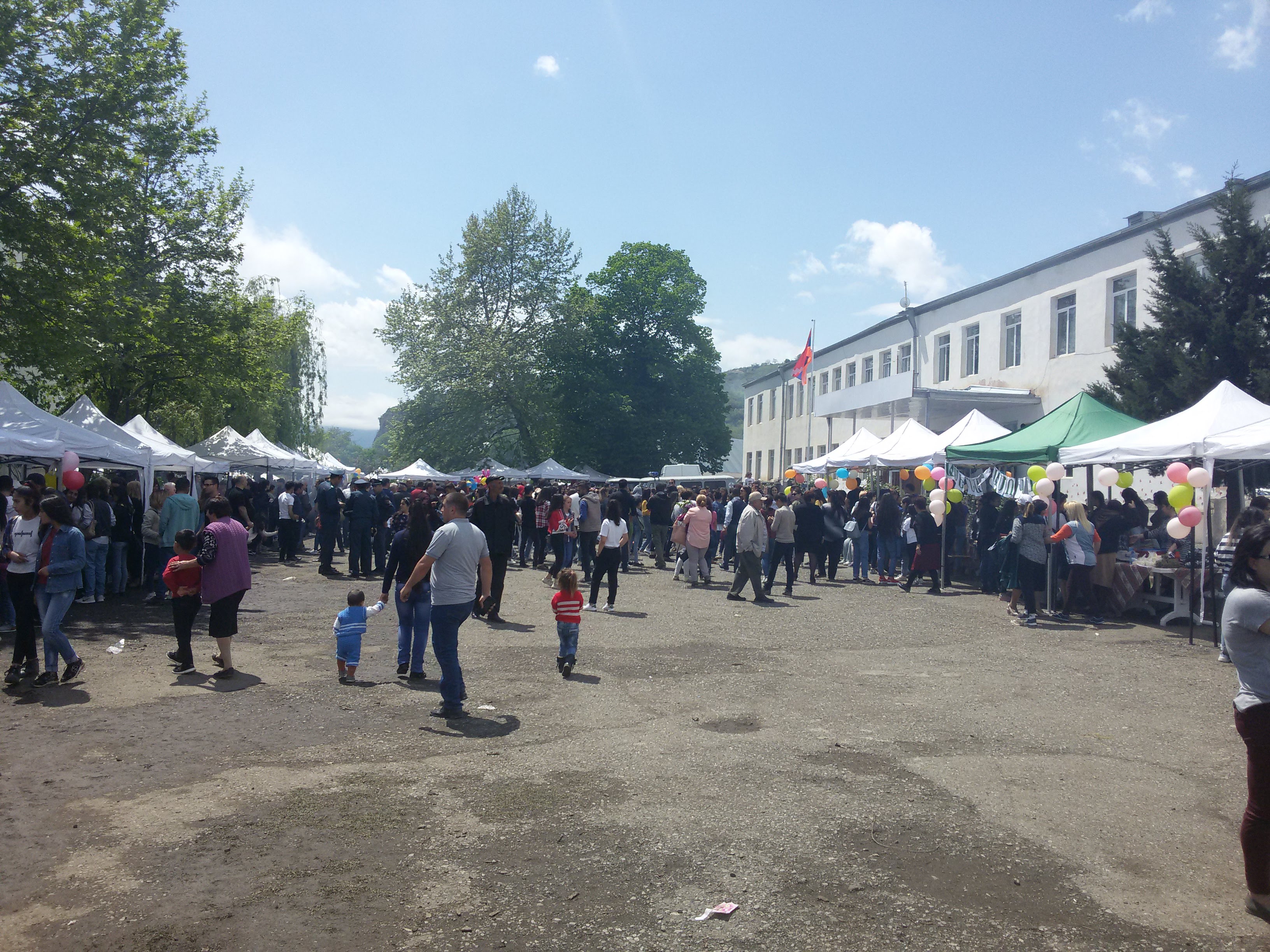|
Khachen
The Principality of Khachen ( hy, Խաչենի իշխանություն, Khacheni ishkhanutyun) was a medieval Armenian principality on the territory of historical Artsakh (present-day Nagorno-Karabakh). The provinces of Artsakh and Utik were attached to the Kingdom of Armenia in antiquity. In the early medieval period, these provinces were under Sassanid or Arab suzerainty until the establishment of the Bagratid Kingdom of Armenia in the 9th century. From the 12th century the Armenian Principality of Khachen dominated the region. The Byzantine emperor Constantine VII addressed his letters to the prince of Khachen with the inscription "To Prince of Khachen, Armenia." According to Abū Dulaf, an Arab traveller of the time, Khachen was an Armenian principality immediately south of Barda'a (modern-day Barda, Azerbaijan).Abū-Dulaf Misʻar Ibn Muhalhil's Travels in Iran (circa A.D. 950) / Ed. and trans. by V. Minorsky. — Cairo University Press, 1955. — p. 74:"''Khajin (Ar ... [...More Info...] [...Related Items...] OR: [Wikipedia] [Google] [Baidu] |
Hasan Jalalyan
The House of Hasan-Jalalyan ( hy, Հասան-Ջալալյաններ) was an Armenian dynasty that ruled the region of Khachen (Greater Artsakh) from 1214 onwards in what are now the regions of lower Karabakh, Nagorno-Karabakh and small part of Syunik. Ulubabian, Bagrat. ''"Հասան-Ջալալյաններ"'' asan-Jalalyans Armenian Soviet Encyclopedia. Yerevan: Armenian Academy of Sciences, 1980, vol. 6, p. 246. It was named after Hasan-Jalal Dawla (Հասան-Ջալալ Դոլա), an Armenian feudal prince from Khachen. The Hasan-Jalalyan family was able to maintain its autonomy throughout several centuries of foreign domination of the region by Seljuk Turks, Persians and Mongols. They, as well as the other Armenian princes and ''meliks'' of Khachen, saw themselves as holding the last bastion of Armenian independence in the region. Through their patronage of many churches and other monuments, the Hasan-Jalalyans helped cultivate Armenian culture throughout the region. By ... [...More Info...] [...Related Items...] OR: [Wikipedia] [Google] [Baidu] |
History Of Nagorno-Karabakh
Nagorno-Karabakh is located in the southern part of the Lesser Caucasus range, at the eastern edge of the Armenian Highlands, encompassing the highland part of the wider geographical region known as Karabakh. Under Russian and Soviet rule, the region came to be known as ''Nagorno-Karabakh'', meaning "Mountainous Karabakh" in Russian. The name Karabakh itself (derived from Persian and Turkic, and meaning "black vineyard") was first encountered in Georgian and Persian sources from the 13th and 14th centuries to refer to lowlands between the Kura and Aras rivers and the adjacent mountainous territory. Following the collapse of Soviet Union, most of this area came under the control of the Artsakh Republic, which had economic, political, and military support from Armenia but has been internationally recognized as a part of Azerbaijan. As a result of the 2020 war, all surrounding territories and some areas within Nagorno-Karabakh were taken back by Azerbaijan, yet the final st ... [...More Info...] [...Related Items...] OR: [Wikipedia] [Google] [Baidu] |
Nagorno-Karabakh
Nagorno-Karabakh ( ) is a landlocked region in the South Caucasus, within the mountainous range of Karabakh, lying between Lower Karabakh and Syunik, and covering the southeastern range of the Lesser Caucasus mountains. The region is mostly mountainous and forested. Nagorno-Karabakh is a disputed territory, internationally recognized as part of Azerbaijan, but most of it is governed by the unrecognised Republic of Artsakh (also known as the Nagorno-Karabakh Republic (NKR)) since the first Nagorno-Karabakh War. Since the end of the war in 1994, representatives of the governments of Armenia and Azerbaijan have been holding peace talks mediated by the OSCE Minsk Group on the region's disputed status. The region is usually equated with the administrative borders of the former Nagorno-Karabakh Autonomous Oblast, comprising . The historical area of the region, however, encompasses approximately . On 27 September 2020, a new war erupted in Nagorno-Karabakh and the surrounding ... [...More Info...] [...Related Items...] OR: [Wikipedia] [Google] [Baidu] |
Artsakh (historic Province)
Artsakh ( hy, Արցախ, Artsʻakh, ) was the tenth province (''nahang'') of the Kingdom of Armenia from c. 189 BC until 387 AD, when it was made part of Caucasian Albania, a subject principality of the Sasanian Empire, following the Peace of Acilisene. From the 7th to 9th centuries, it fell under Arab control. In 821, it formed the Armenian principality of Khachen and around the year 1000 was proclaimed the Kingdom of Artsakh, one of the last medieval eastern Armenian kingdoms and principalities to maintain its autonomy following the Turkic invasions of the 11th to 14th centuries. Name Cuneiform inscriptions left by Urartian kings mention a land or lands called "Ardakh/Adakh", "Urdekhe/Urtekhini", and "Atakhuni", which some scholars identify with Artsakh. When speaking about Armenia in his ''Geography'', the classical historian Strabo refers to an Armenian region which he calls "Orchistene", which is also believed to be a rendering of the name Artsakh. Strabo. ''Geogra ... [...More Info...] [...Related Items...] OR: [Wikipedia] [Google] [Baidu] |
Melikdoms Of Karabakh
The Five Melikdoms of Karabakh, also known as Khamsa Melikdoms (), were Armenian feudal entities on the territory of modern Nagorno-Karabakh and neighboring lands, from the dissolution of the Principality of Khachen in the 15th century to the abolition of ethnic feudal entities by the Russian Empire in 1822. Etymology ''Khamsa'', also spelled ''Khamse'' or simply ''Khams'' means 'five' in Arabic. The principalities were ruled by '' meliks''. The term () , from ar, ملك ''malik'' ('king'), designates an Armenian noble title in various Eastern Armenian lands. The principalities ruled by ''meliks'' became known in English academic literature as ''melikdom''s or ''melikates.'' History Background There were several Armenian melikates (dominions ruled by ''meliks'') in various parts of historical Armenia: in Yerevan, Kars, Nakhichevan, Gegharkunik, Lori, Artsakh, Utik, Northwestern Iran and Syunik. The Five Melikdoms were ruled by dynasties that represented branches of th ... [...More Info...] [...Related Items...] OR: [Wikipedia] [Google] [Baidu] |
Haterk
Haterk ( hy, Հաթերք) or Hasanriz ( az, Həsənriz) is a village ''de facto'' in the Martakert Province of the Political status of Nagorno-Karabakh, breakaway Republic of Artsakh, ''de jure'' in the Kalbajar District of Azerbaijan, in the disputed region of Nagorno-Karabakh. The village has an ethnic Armenians, Armenian-majority population, and also had an Armenian majority in 1989. History After the Battle of Manzikert in 1071, the Seljuk dynasty, Seljuks conquered most of the remnants of Bagratid Armenia, which had been largely annexed by the Byzantine Empire in the 11th century. The Kingdom of Syunik, Syunik, Kingdom of Artsakh, Khachen (Artsakh) and Kingdom of Tashir-Dzoraget, Tashir principalities remained unconquered however. The Syunik and Khachen principalities had close ties, their royal families intermarried, and their respective principalities functioned as refuges and bastions for each other during times of need. During the end of the 12th century, Seljuk power ... [...More Info...] [...Related Items...] OR: [Wikipedia] [Google] [Baidu] |
Kingdom Of Armenia (Middle Ages)
The Bagratid Kingdom of Armenia, also known as Bagratid Armenia ( xcl, Բագրատունեաց Հայաստան, or , , 'kingdom of the Bagratunis'), was an independent Armenian state established by Ashot I Bagratuni of the Bagratuni dynasty in the early 880s following nearly two centuries of foreign domination of Greater Armenia under Arab Umayyad and Abbasid rule. With each of the two contemporary powers in the region—the Abbasids and Byzantine Empire, Byzantines—too preoccupied to concentrate their forces in subjugating the region, and with the dissipation of several of the Armenian ''nakharar'' noble families, Ashot succeeded in asserting himself as the leading figure of a movement to dislodge the Arabs from Armenia. Ashot's prestige rose as both Byzantine and Arab leaders—eager to maintain a buffer state near their frontiers—courted him. The Abbasid Caliphate recognized Ashot as "prince of princes" in 862 and, later on, as king (in 884 or 885). The establishment ... [...More Info...] [...Related Items...] OR: [Wikipedia] [Google] [Baidu] |
Zar, Azerbaijan
Zar (; hy, Ծար, Tsar; , also ''Tzar'') is a village in the Kalbajar District of Azerbaijan. Etymology Armenian architectural historian Samvel Karapetyan writes that the settlement was first mentioned as "Tsar" in 1289. In the records of Dadivank Monastery in 1763, it is referred to as ''Mets Tsar'' ( hy, Մեծ Ծար, ), and in the 18th century, with an increased nomadic presence in the region, ''Zar'', a derivative of ''Tsar'', began to be used as a name for the village. An Azerbaijani legend suggests a different origin. A poor young man named Zaza once lived in this village. He was in love with a girl named Nazı, but her parents were against their relationship. Zaza then decided to seek assistance from Nadir Shah. He planted a watermelon in a narrow-necked jar. The surprised shah approved and ordered that Nazı be given to Zaza. However, as soon as Nadir Shah left town, Nazı's family went to Zaza's house and murdered him before throwing his body into a well. Zaza's mo ... [...More Info...] [...Related Items...] OR: [Wikipedia] [Google] [Baidu] |
Armenians
Armenians ( hy, հայեր, '' hayer'' ) are an ethnic group native to the Armenian highlands of Western Asia. Armenians constitute the main population of Armenia and the ''de facto'' independent Artsakh. There is a wide-ranging diaspora of around five million people of full or partial Armenian ancestry living outside modern Armenia. The largest Armenian populations today exist in Russia, the United States, France, Georgia, Iran, Germany, Ukraine, Lebanon, Brazil, and Syria. With the exceptions of Iran and the former Soviet states, the present-day Armenian diaspora was formed mainly as a result of the Armenian genocide.Richard G. Hovannisian, ''The Armenian people from ancient to modern times: the fifteenth century to the twentieth century'', Volume 2, p. 421, Palgrave Macmillan, 1997. Armenian is an Indo-European language. It has two mutually intelligible spoken and written forms: Eastern Armenian, today spoken mainly in Armenia, Artsakh, Iran, and the former ... [...More Info...] [...Related Items...] OR: [Wikipedia] [Google] [Baidu] |
Bagratuni Dynasty
The Bagratuni or Bagratid dynasty ( hy, Բագրատունի, ) was an Armenian royal dynasty which ruled the medieval Kingdom of Armenia from c. 885 until 1045. Originating as vassals of the Kingdom of Armenia of antiquity, they rose to become the most prominent Armenian noble family during the period of Arab rule in Armenia, eventually establishing their own independent kingdom. Their domain included regions of Armenia such as Shirak, Bagrevand, Kogovit, Syunik, Lori, Vaspurakan, Vanand and Taron. Many historians, such as Cyril Toumanoff, Nicholas Adontz and Ronald Suny, consider them to be the progenitors of the Georgian royal Bagrationi dynasty. Early history The name "Bagratuni" derives from ''Bagarat'', a Parthian variant of the Old Iranian name ''Bagadata'' ("God-given"). Historian Cyril Toumanoff speculated that a general of King Tigranes II of Armenia () named Bagadates may have been the earliest known member of the Bagratuni family, which first emerged as ... [...More Info...] [...Related Items...] OR: [Wikipedia] [Google] [Baidu] |
Karabakh Khanate
The Karabakh Khanate was a semi-independent Turkic Caucasian khanate on the territories of modern-day Armenia and Azerbaijan established in about 1748 under Iranian suzerainty in Karabakh and adjacent areas. The Karabakh Khanate came under the control of the Russian Empire in 1805 during the course of the Russo-Persian War (1804–13). The Russian annexation of Karabakh was not formalized until the Treaty of Gulistan in 1813, when Fath-Ali Shah of Qajar Iran officially ceded Karabakh to Tsar Alexander I of Russia. The khanate continued to exist under Russian suzerainty until its formal abolition in 1822, when the Karabakh Province, with a military administration, was formed. Russian control was decisively confirmed by the Treaty of Turkmenchay with Iran in 1828. History Background The precursor of the Karabakh Khanate, the Safavid province of Karabakh, was one of the provinces established in the northern part of the Safavid Empire. The Safavid shah of Iran Tahma ... [...More Info...] [...Related Items...] OR: [Wikipedia] [Google] [Baidu] |







.png)